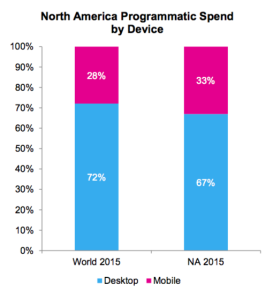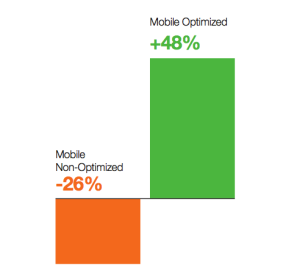By Evan Krauss, VP Publisher Development, PubMatic
At the recent Ad Revenue Europe conference in London, cross-device marketing was top of mind for publishers. On the panel, “Mobile Video Your Time Has Come,” speakers agreed that the industry needs to stop treating mobile as a separate entity, similar to the way digital media was treated 10 years ago. Consumers are driving the changes, and the media industry needs to keep up.
eMarketer estimates that 42% of the total population worldwide will have a mobile phone this year, with 1.86 billion of them being smartphone users.1 Additionally, according to MAGNA GLOBAL, mobile ad spending will represent 28% of total programmatic spending worldwide in 2015.2 Given this scale, publishers and advertisers need to understand how to execute across devices to create a true, cross-platform experience for consumers.

Source: Magna Global (2015)
Consumer migration to mobile devices has changed the way we buy and sell media, and has presented publishers with new and exciting ways to reach audiences. The nuances of mobile create a highly targetable, very personal experience, made available by rich data such as GPS location and device ID. In addition, the highly engaging nature of native apps and ad formats optimized for mobile (e.g. MRAID standard and mobile-specific ad formats developed by the IAB) contribute to the personalization of the device, providing content creators the opportunity to develop extremely immersive ad environments.
Both publishers and buyers are committed to cross-platform solutions, with publishers creating inventory packages that encompass mobile and desktop and buyers developing media plans that contain mobile and desktop channels. We are seeing this shift to a more holistic approach to the buying and selling of media organically, but there are a few things for publishers to keep in mind when navigating this new territory.
Bundle Inventory Together While Keeping Data in Mind
If they aren’t already, publishers should begin to integrate monetization strategies dynamically across devices. However, as they take on this transition, they need to make sure that they are taking advantage of the unique data assets that are available for both mobile and desktop. With the growing number of first- and third-party data sources, many publishers are able to make smarter decisions about when and where to reach consumers and with the right message. Layering data into integrated strategies enables publishers to tell a sequential, relevant story as consumers jump between devices.
Partner with Technology Vendors with Cross-Device Solutions
The same consumer is engaging with a publisher’s content across multiple devices, making it imperative that they partner with an independent vendor that supports cross-device identification and mobile optimization. One of the major challenges with the mobile web is that consumers often block cookies, severely limiting the ability for behavioral targeting. Working with a cross-device solution will enable a user on a desktop to be identified on mobile, circumventing the cookie blocking, thereby making mobile web inventory more targetable. Viewability also becomes an issue when publishers use the same website for both desktop and mobile, instead of creating a separate mobile optimized site. Inventory on mobile optimized sites saw a 48 percent year-over-year increase in average CPM in Q3 2015. Not only does this increase revenue for publishers, but it also attracts advertiser partners to their high-quality inventory.

Source: PubMatic (2015)
Employ Programmatic Direct Campaigns
As publishers and buyers work together to find harmony in this new advertising marketplace, publishers should utilize programmatic direct solutions to drive higher priced demand for their more premium assets. With cross-device private marketplace (PMP) deals, publishers can protect their first-party data by only making it available to certain buyers. This provides higher quality inventory, increases viewability for campaigns, diminishes ad fraud and guarantees brand safety. Publishers are able to earn more money for their premium inventory, buyers have confidence in their campaigns and the mutually beneficial buy-sell relationship takes a step forward.
Mobile devices brought a heightened level of connectivity to society, but as we look to the future of the “Internet of Things,” it seems that we haven’t even broached the capabilities of connected devices. As these new platforms become more prominent, publishers will need the technology and strategy to integrate them into their monetization plans.
1: eMarketer (2015)
2: Magna Global (2015)





